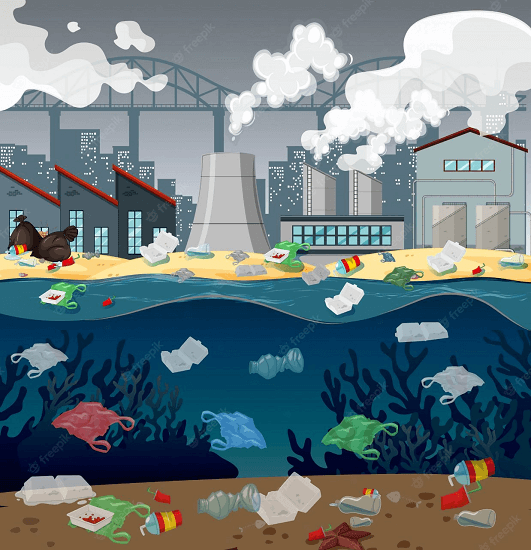Advantages and Disadvantages of PollutionBy no means can it be said that there are more benefits than harms of pollution, which should always be taken into account. The blessing of nature is used by people without considering its long-term effects. This is demonstrated in real life by the amount of environmental pollution caused by deforestation, industrial smoke, and human waste. So it is imperative that people begin to understand the need to preserve the environment. Either way, pollution's adverse effects would create a world where no one could survive. Let us discuss the possible advantages and disadvantages of pollution: 
AdvantagesHelping Plants and Trees to Grow The CO2 that is produced as a result of pollution aids in photosynthesis and the growth of plants and trees. Additionally, the generated nitrogen also aids in plant growth. Keeping the Temperature Low Low temperatures are maintained by pollution, which acts as a heat shield by preventing heat from penetrating the surface of the Earth and lowering its temperature throughout the summer. Climate Change becomes a Slow Process Due to the presence of numerous atmospheric gases that generate heat while Sulphur in the atmosphere generally maintains our environment's coolness, the path of climate change slows down. DisadvantagesPollutes the Environment Pollution has a negative impact on the environment in that it causes significant harm to the natural world. Pollution has an impact on the land, water, air, and nearby areas. Nature has given us a gift in the form of our environment, but as it is continuously depleting, the natural cover or protection is getting lost. The ozone layer, which shields us from the sun's harmful ultraviolet rays, has decreased as a result of deforestation, and pollution has compounded this problem by hastening the ozone layer's deterioration. Causes Many Diseases Because it pollutes the environment, pollution is one of the primary causes of many diseases and various illnesses, such as those that affect the lungs or the heart, among others. Thus, pollution causes a lot of suffering to the people. The past few decades have also seen the emergence of numerous diseases that are both unknown and incurable. As a result, the pollution level needs to be periodically evaluated. Global Warming The layer of pollution traps heat and allows it to stay in the atmosphere, which raises the temperature there. As a result, the Earth becomes hotter. Nature is worried by this heat as it gradually begins to melt the glacier's ice. 
As we are all aware, the melting of glaciers caused by global warming is causing the sea level to rise and the encircling of many islands by water. Cause of Acid Rain Acid rain's main cause is pollution, which is also one of its main disadvantages. When it rains, acid rain clouds form due to the production of chemicals such as sulfur dioxide and nitrogen oxides, which have an impact on structures and people's health. The marble of the Taj Mahal, which has changed from white marble to yellow, is a very current example of the repeated effects of acid rain. Depletion of the Ozone Layer Chlorofluorocarbons (CFCs), which are created by a variety of human activities, are causing the ozone layer in the Earth's atmosphere to thin out. The ozone layer is being depleted, which is causing a hole that is getting bigger every day as a result of pollution. Since the ozone is being degraded as a result of growing pollution, it is contributing to the rise in cancer rates by emitting harmful UV radiation into the atmosphere. Impacted Wildlife As pollution is increasing day by day, more and more wildlife species are facing extinction. Animal life is impacted as a result of the damage that pollution is causing to trees and other natural vegetation. Polluted Air It is the contaminating of the open air with various contaminants, such as hazardous gases and chemicals. This kind of contamination may result from burning materials, gases released by moving vehicles, or hazardous vapours released as a byproduct of industrial processes. One of the most significant adverse effects of air pollution, according to experts, is global warming. Water Pollution Due to the increasing pollution of various types, the water on the Earth is also getting affected a lot. Pollutants like bacteria, chemicals, and particulates can contaminate water, lowering its cleanliness. One of the most prevalent types of pollution includes trash and oil seepage. It mostly happens in bodies of water like lakes, aquaria, rivers, or even underground reservoirs. Soil Pollution Soil is also not untouched by the adverse effects of pollution. Land Pollution is another name for soil pollution. Natural life is unable to flourish due to soil or land contamination. It covers how land is used for people, irrigation, and wildlife. Hazardous waste, mining waste and littering, unsustainable farming methods, seepage into the soil, etc., are some of the extremely typical sources of soil pollution. Noise Pollution The loud noise generated by human activities causes noise pollution, which reduces the quality of life in the affected area. It can fire from several sources, including trains, automobiles, loud music, sporting events, aeroplanes, pyrotechnics, and more. Noise pollution can cause hearing loss (may be permanent or temporary), irritation, headache and frequent disturbance to wildlife. Radioactive Pollution One of the most harmful types of pollution is radioactive pollution. It is extremely dangerous and may even be fatal. This form of contamination, which dates to the 20th century, is still present. This has changed as a result of advances in nuclear physics and nuclear weapons. Radioactive poisoning is the outcome of radioactive pollution, which also pollutes the air and the land. Another cause of this pollution is the inappropriate disposal of nuclear waste as well as leaks or accidents at nuclear power plants. The effects of this dangerous form of pollution include birth abnormalities, cancer, health decline, and even sudden death. Lighting Pollution Over-illumination of a particular region that is deemed intrusive is known as light pollution. If you can see the stars, that is, gaze up at the sky, then the area is not that polluted, according to the most frequent method of determining pollution levels. Large well-lit cities, billboards, as well as other forms of advertising, and late-night laser light entertainment are all examples of pollution. Thermochemical Pollution Temperature rise in a specific location over time is referred to as thermal pollution. Air pollution, as well as the discharge of carbon gases in that region, are frequently to blame for this increased heat effect since they trap more heat on Earth. The thermal cycle of the Earth is natural, although extreme heat can have long-term consequences. These pollution-related repercussions include deforestation, power plants, a significant carbon footprint, etc. Visual Pollution Visual pollution is a type of pollution that isn't very bad, yet it may be considered unpleasant to the eyes. Visual obstruction is usually caused by an increased amount of pollution in the air, such as the pollution we commonly see at certain festivals as a result of the smoke caused by firecrackers. This type of pollution also occurs when views are obstructed by tall buildings, billboards, power lines and construction areas. The impacts on your health are not immediate, but they might be gradual. |
 For Videos Join Our Youtube Channel: Join Now
For Videos Join Our Youtube Channel: Join Now
Feedback
- Send your Feedback to [email protected]
Help Others, Please Share










